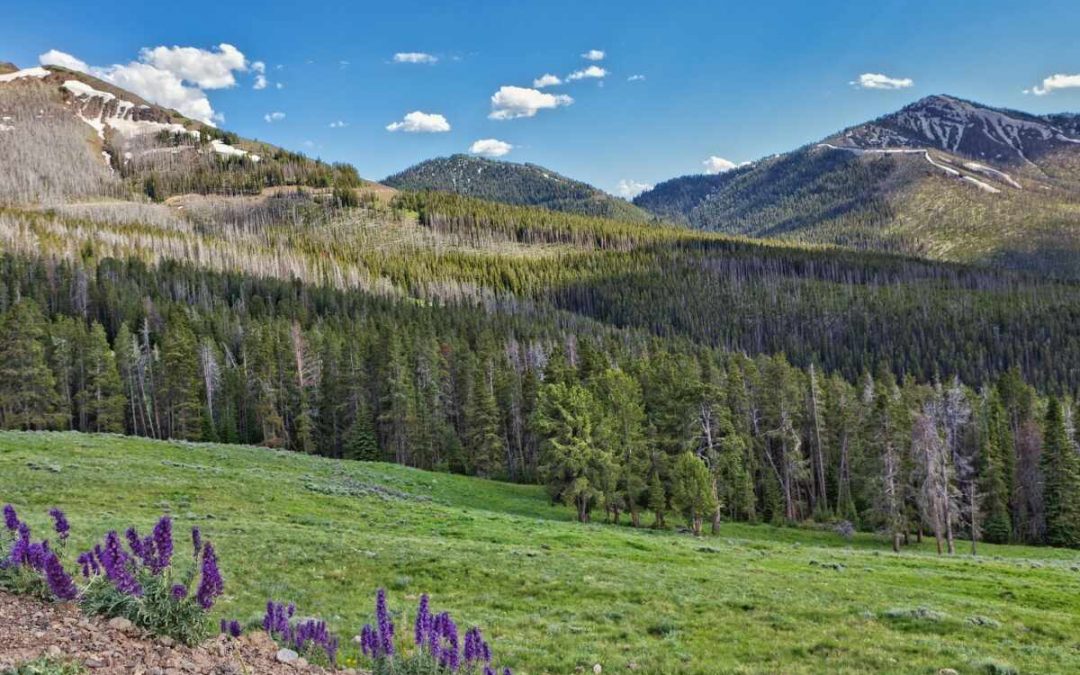Wyoming is one of the grassiest states in the US. thanks to an abundance of prairies. Unfortunately, when it comes to home lawns, only a few turfgrass species are suitable for the Equality State’s tough climate. Discover the 5 best grass types for Wyoming.
In this article, we will cover:
Warm-Season vs. Cool-Season Grass Types
There are two categories of turfgrass: warm-season and cool-season grasses. Wyoming’s arid continental climate has prolonged, cold winters, making it best suited for cool-season grass types. However, buffalograss, a native warm-season prairie turfgrass, has what it takes to thrive in Wyoming.
Warm-Season Grasses
Warm-season grass types enter their active growth phase when temperatures are between 75 to 95 degrees Fahrenheit. They thrive in the southern half of the U.S. Most cultivars are drought tolerant and require frequent mowing at reduced heights in the summer.
Warm-season grasses in Wyoming wait until late spring through early fall to push out fresh growth and go dormant throughout the winter.
Cool-Season Grasses
Cool-season grasses grow best in the northern half of the U.S. These grasses thrive in cooler temperatures between 55 to 75 degrees Fahrenheit. Cool-season cultivars enter their green-up phases in early spring and again in the fall. Many species go dormant in the summer.
5 Warm-Season and Cool-Season Grasses for Wyoming
The following warm and cool-season grass types adapt to the climatic and soil conditions of Wyoming:
1. Buffalograss
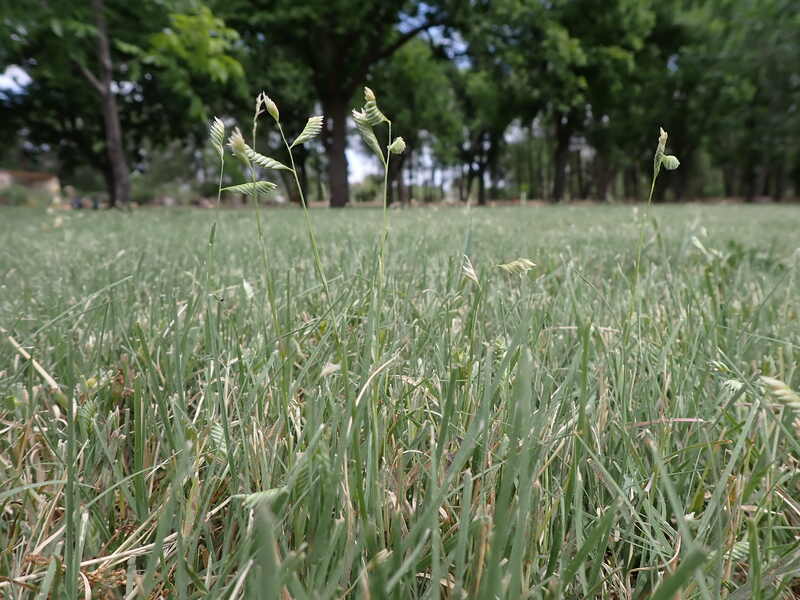
Photo Credit: Matt Lavin / Flickr / CC BY-SA 2.0
Buffalograss is the only warm-season grass that survives Wyoming’s climate. It thrives in the state’s lower altitudes and dry summers. This fine-textured, gray-green turfgrass has excellent drought tolerance and more cold resistance than other warm-season cultivars.
Buffalograss is a low-maintenance turfgrass, requiring little mowing or fertilization. It thrives in full sun. Cultivars struggle in shady areas and do not respond well to overwatering. Buffalograss creates a sparse appearance and is vulnerable to weeds.
- Classification: Warm-season grass
- Spreads by: Stolons
- Shade tolerance: Very low — best suited for full sun
- Drought resistance High
- Foot traffic tolerance: Very low, but light use or rare heavy use is OK
- Maintenance needs: Low mowing frequency — once per week or less
- Mowing height: 2-4 inches or leave unmowed
- Potential for disease: Low; bipolaris leaf spot may occur
- Potential for pests: Low; most common pests are mealybugs, buffalograss webworms, mites, short-tailed crickets, and chinch bugs
- Soil pH: 6.5-7.5
- Soil type: Native soils, not sandy soils
2. Fine Fescue
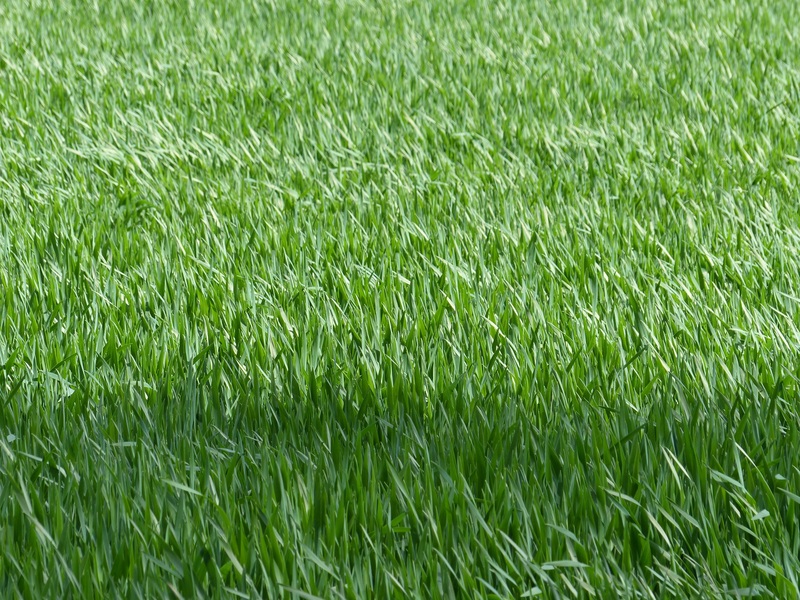
Photo Credit: PxHere / CC0 1.0
Fine fescues are a group of turfgrass cultivars that require less fertilization and irrigation than other cool-season grass types. Many homeowners mix fine fescue with other grasses like Kentucky bluegrass to create a dense and resilient lawn.
Fine fescue is a clumping grass with a fine texture. It is a superb choice for small lawns. Specimens do not tolerate heavy foot traffic. Many varieties, like hard fescue and creeping red fescue, thrive in areas with hot summers and cold winters.
Once established, fescues are low-maintenance. They establish quickly, are drought resistant, cold-tolerant, and grow well in poor soil conditions. Fine fescue is the most shade-tolerant of the cold-season grass types.
- Classification: Cool-season grass
- Spreads by: Bunch-type grasses with one exception: creeping red fescues possess rhizomes
- Shade tolerance: Moderate to high
- Drought resistance: Moderate to high
- Foot traffic tolerance: Low to moderate
- Maintenance needs: Low
- Mowing height: 1.5-3 inches
- Potential for disease: Moderate; red thread, leaf spot, dollar spot, summer patch, powdery mildew, and downy mildew can occur
- Potential for pests: Moderate; most common pests are chinch bugs, sod webworms, grubs, billbugs, winter mites, and crane flies
- Soil pH: 5.5-6.5
- Soil type: Well-drained soils; tolerates infertile and sandy soils
Other notes: Often used in a mix with other cool-season grasses, especially in sun/shade mixes
3. Kentucky Bluegrass
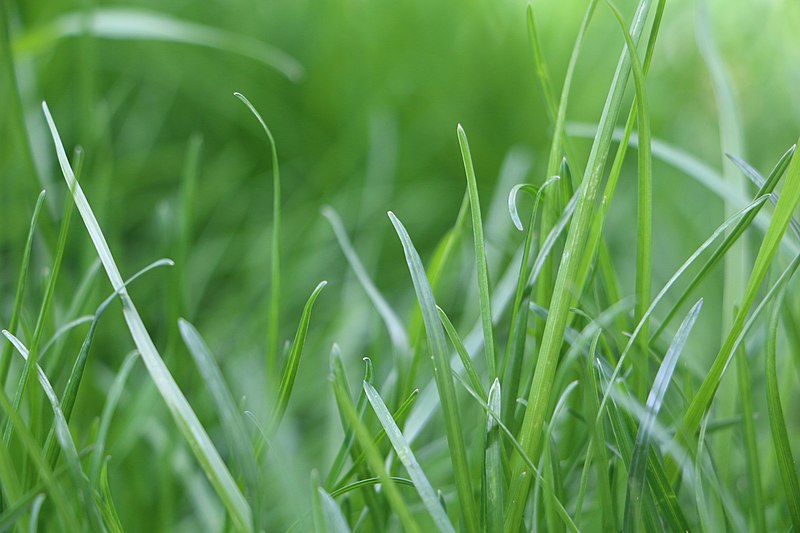
Photo Credit: Pilot138-17 / Wikimedia Commons / CC BY-SA 4.0
Kentucky bluegrass is the most popular cool-season turfgrass in Wyoming. Cultivars are dense and blue-green and thrive in full sun. Kentucky bluegrass tolerates partial shade and has good heat tolerance with the right irrigation.
It grows best in the mild temperatures of fall and spring and goes dormant during the summer. The cool-season turfgrass is hardy and recovers quickly from damage, making it a good option for a backyard that gets plenty of foot traffic.
Many homeowners combine Kentucky bluegrass with other cool-season cultivars to create a dense and resistant home lawn. Cultivars are fairly high-maintenance with high water and fertility needs. Kentucky bluegrass requires regular mowing and dethatching.
- Classification: Cool-season grass
- Spreads by: Rhizomes
- Shade tolerance: Low to moderate; prefers full sun
- Drought tolerance: Moderate
- Foot traffic tolerance: Low to moderate; recuperates well
- Maintenance needs: Moderate
- Recommended mowing height: 2-3 inches; mow taller during summer
- Potential for disease: Moderate to high; snow molds, summer patch, leaf spot, fairy rings, dollar spot, and necrotic ring spot can occur
- Potential for pests: Moderate to high; most common pests are chinch bugs, bluegrass billbugs, grubs, and greenbugs
- Soil pH: 6-7
- Soil type: Well-drained, fertile soils
Other notes: It is most often mixed with other species. Regular watering is necessary because of its shallow roots. Poor soil conditions and lack of water can cause diseases, but newer cultivars are more hardy and resistant to disease.
4. Perennial Ryegrass

Photo Credit: manfredrichter / Pixabay / License
Perennial ryegrass is low-maintenance and thrives in areas with good drainage. It is a dense, dark green grass that stands up to heavy foot traffic. It is resistant to pests and tolerant of poor soil.
Perennial ryegrass does not withstand high temperatures above 90 degrees Fahrenheit, going dormant during hot summers. Its roots establish quickly, and it has a long growing season. Perennial ryegrass is often used for winter overseeding on golf courses and athletic fields.
- Classification: Cool-season grass
- Spreads by: Tillers (Bunch-type)
- Shade tolerance: Low; requires four to five hours of sunlight
- Drought tolerance: Low
- Foot traffic tolerance: High; recuperates poorly
- Maintenance needs: High; requires frequent watering, mowing, and fertilization
- Recommended mowing height: 2-3 inches
- Potential for disease: High; susceptible to flag rust, stem rust, leaf spot, downy mildew, brown patch, and red thread
- Potential for pests: High; chinch bugs and greenbug aphids can occur
- Soil pH: 6-7
- Soil type: Adaptable; prefers well-drained, fertile soils
5. Tall Fescue
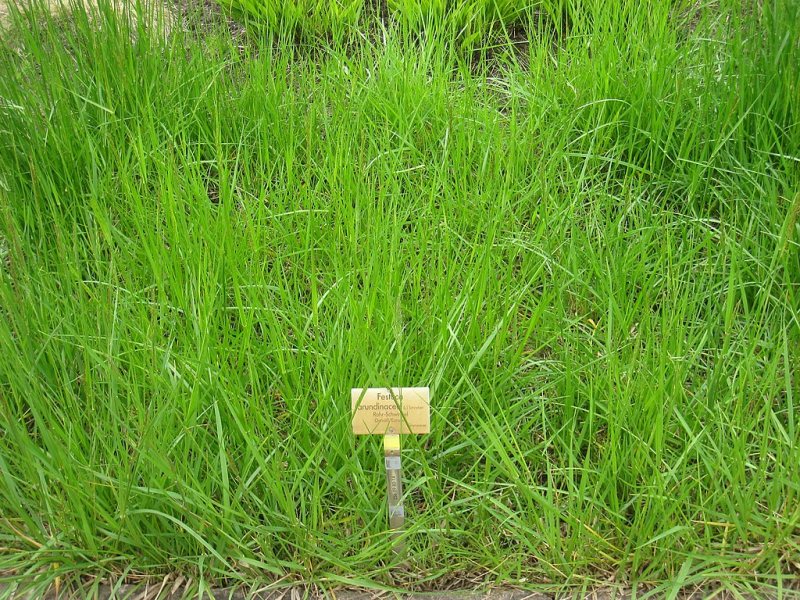
Photo Credit: Daderot / Wikimedia Commons / Public domain
Tall fescue is a deep‑rooted bunchgrass that thrives in full sun but is shade tolerant and cold-resistant. It has a coarse texture with a medium to dark green color and an extensive root system.
Hybrid varieties offer a more aesthetically pleasing color and texture for home lawns. Unfortunately, many varieties require overseeding with perennial ryegrass for a dense appearance. Additionally, many homeowners mix tall fescue with Kentucky bluegrass for a more dense and resilient lawn.
Tall fescue remains green during the winter and is the most heat-tolerant cool-season grass, thanks to its deep roots. Cultivars are resistant to weeds and insects and adapt to most soils.
- Classification: Cool-season grass
- Spreads by: Tillers (Bunch-type)
- Shade tolerance: Moderate to high
- Drought tolerance: Moderate
- Foot traffic tolerance: Moderate; recovers slowly
- Maintenance needs: Moderate
- Recommended mowing height: 2-4 inches (Check your cultivar and state recommendations. Many cultivars grow best when mowed on the tall side.)
- Potential for disease: Low to moderate; can be prone to leaf spot, seedling disease, and brown patch
- Potential for pests: Low to moderate; susceptible to armyworms, cutworms, sod webworms, and grubs
- Soil pH: 5.5-6.5
- Soil type: Adaptable; prefers clay soils
Other notes: Fertilize in September and November. Plant fresh grass seeds every couple of years to maintain a dense lawn and fill thinning spots.
FAQ About Wyoming Grass Types
Loam soil with a balance of sand, silt, and clay is the best soil type for home lawns. Loamy soils drain well, retain nutrients, and allow vital oxygen to reach plant roots.
Wyoming soils are deep, rocky, and overly drained, leaching vital nitrogen. It is important to have your soil tested annually with your local University of Wyoming extension office. Primarily, Wyoming soils require fertilizer high in nitrogen.
Groundcovers are a group of low-growing, spreading plants that make a great, low-maintenance turfgrass replacement. Some great options for your Wyoming landscape include:
●Breckland Thyme
●Creeping Phlox
●Myrtle
●Stonecrop
●Yarrow
Choosing Plant and Grass Varieties for Your Wyoming Landscape
When designing your landscape, consider using Wyoming native plants to create a low-maintenance and drought-resistant landscape.
Before choosing a grass type for your lawn in Wyoming, you will want to consider:
- Your area’s Hardiness Zone; Wyoming’s USDA Zones are 2a-5b
- Climate and seasonal conditions
- Sunlight and watering capabilities of your landscape
Yard work in Wyoming can feel like thankless work when there are so many chores to complete. Let Wikilawn connect you with a local lawn care pro to take care of your yard chores, so you can spend more time enjoying your outdoor space.

